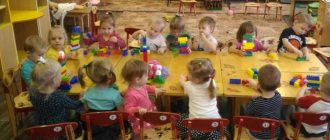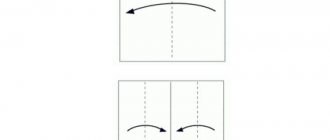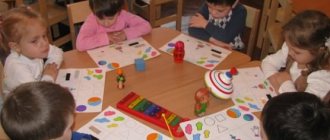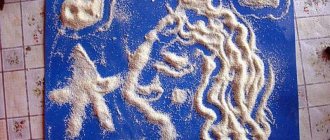Long-term planning for design and manual labor in the middle group. Target
Transcript
1 Subject Long-term planning FOR CONSTRUCTION AND MANUAL LABOR in the middle group p/p Educational topic Lesson topic Purpose Materials and equipment Literature “Goodbye, summer! Hello, kindergarten! “In the Land of Invention” “Forest kindergarten”. “Squirrel Gifts” September Learn to organize space for construction; plan activities, model; design various pieces of furniture; unite buildings with a single plot. Encourage the creation of new versions of already familiar buildings, develop design abilities, and form ideas about geometric shapes. To acquaint children with natural materials, with their properties (shape, surface texture), to interest children in the possibility of using it to create crafts. October Cubes. a box with construction materials, an envelope, flat paper models of various shapes, pencils, felt-tip pens. A toy or image of a squirrel, a basket, pine cones, acorns, nut shells, ash and maple wings, feathers, pebbles, twigs, plasticine, crafts made from natural materials, -26 VKT.2010, - p.79
2 “Visiting a fairy tale” “My favorite games” “Music box” “Castle for a princess” “Turtles” “Do-it-yourself Philharmonic” Develop children’s design skills, practice constructing strong buildings with ceilings by building paper models with bricks , making floors from plates and boards, constructing superstructures on floors, decorating roofs with various details; practice distinguishing and naming basic geometric shapes and shading. Develop imagination, creativity, the ability to independently perform a sequence of actions, generalize and compare. Teach children to divide plasticine into parts, practice orientation in space, strengthen the skills of rolling a ball from plasticine November Teach children to follow the construction plan, take into account color, shape, size. Colored pencils, building material, flat paper models of different sizes and colors. Finger game: "Turtle". Half of a walnut shell, plasticine, sample, stacks of building set - wooden, gnome toys, additional material - medical devices of material, -20 VKT.2010, - p.83 material, -13; Internet resources,
3 6. “We are one big family” “Bear” Develop an interest in manual labor, a desire to create crafts with your own hands. Encourage children to independently select material. December Plasticine, scales of cones, pits from plums or apricots, maple lionfish, watermelon seeds, a toy bear, a sample of crafts VKT.2010, - from “The Safe World of Childhood” “The Magical World of Books” “Houses, a shed and” “Mouse Rucker” Exercise children in fencing small spaces with bricks and plates installed vertically and horizontally; in the ability to make overlap; in mastering spatial concepts (in front, behind, below, above, left, right); in entertainment and naming colors. Develop independence in finding design methods; promote playful communication. Strengthen the ability to construct a craft from natural materials, teach how to choose materials for small parts, and navigate in space. January Felt-tip pens, construction kits. Reading a Russian folk tale: “The Little Mouse” Half a walnut shell, watermelon, pumpkin seeds, a piece of yarn, a thin twig, paper ear and tail blanks, glue, toy material, -21 VKT.2010, - p.86
4 “Active lifestyle” “Beauty will save the world” “How to work with these cubes and bricks” “Chicks on a green meadow” Give children the opportunity to independently become acquainted with cubes, bricks, prisms (distinguish the shapes, name them); lead to an understanding of the functional purpose of the material to build various structures. Learn to experiment and independently discover the structural properties of the material. Develop imagination. Encourage connecting and placing pieces in space in different ways. Cultivate interest in constructive activities. To consolidate the ability to design from pine cones, to introduce a new method of fastening (adhesive) parts made of this material to each other. February Tabletop building materials: cubes, bricks, prisms. (10 pieces of each type for 1 child) Listening to the song: “Chickens.” Music Vitaly Alekseev, words by Marina Frolova. Pine cones of different sizes, watermelon seeds, pumpkin seeds or small lionfish, paper blanks for eyes, plasticine, PVA glue, craft sample. material, -21; online resources VKT.2010, - p.94
5 Construction “Friendly guys” “I love you, Voronezh” “In the land of different words” “Animal houses” “Mushroom glade”. “Thirtieth Kingdom” Exercise children in fencing small spaces with bricks and plasticine. Develop independence in finding design methods, promote playful generalization. Learn to analyze a sample, transfer the knowledge and skills acquired in working with one material to the process of making crafts from another material. March Develop children's constructive skills; practice in the construction of durable buildings with overlapping buildings by lining paper models with bricks, making coverings from plates and boards. Constructing superstructures on floors, decorating roofs with various details. Develop imagination, creativity, the ability to independently perform a sequence of actions, generalize, compare. Felt pens, construction kits Half a walnut shell, plasticine, Squirrel toy, cardboard clearing stand Colored pencils, construction material. Flat paper models of different sizes and colors. material, -21 VKT.2010, - p.81 material, -28
6 “Healthy lifestyle” “In a world of different sounds” “Chickens are football players” “Trucks and cars” Strengthen the ability to design from pine cones. Introduce a new method of fastening (adhesive) parts made of this material to each other. Development of spatial orientation in children. April Give children a general idea of freight transport; exercise in its design, in analyzing samples, in transforming structures according to given conditions; give an idea of the construction part of the cylinder and its properties; clarify children’s ideas about geometric shapes; encourage the search for their own solutions, develop the ability for planar modeling. Pine cones of different sizes, watermelon, pumpkin or small lionfish seeds, PVA glue. Construction kits, scissors, brushes, glue VKT.2010, - p.94 material, “Week of Polite Sciences” “The Magic Forest of Lesovichka” Strengthen the ability to use natural materials to create crafts. Develop a sense of aesthetics. To develop an interest in manual labor and a desire to create crafts with your own hands. An image of the fairy-tale character Lesovichka, large fresh tree leaves, a large sheet of paper or thin cardboard. VKT.2010, - p.13
7 “The World Around Us” “Week of Whys” “Voronezh Bridges” “Why does the boat float?” 19. Pedagogical diagnostics May Give children an idea of bridges, their purpose, structure; practice building bridges; consolidate the ability to analyze examples of buildings and illustrations. Introduce children to a stencil ruler (with geometric shapes), practice working with it, comparing shapes, highlighting similarities and differences. Strengthen the ability to construct a craft from natural material by connecting a flying piece of plasticine Construction kits, stencil rulers, felt-tip pens. Photo of Voronezh bridges Half a walnut shell, a leaf of any tree, a paper flag, plasticine, glue, frog-frog (toy) material, -37 VKT.2010, - p.84 *Note: manual labor is carried out in the average flu 2 times per month (week after week) in free activity.
Card index of household chores for children of the middle group.
Card No. 1
.
“Order in the closet with toys and manuals”
Target:
teach children to independently and aesthetically arrange toys and aids, maintain order in closets, and wipe dust. Develop hard work and the ability to see disorder. To cultivate aesthetic taste and the desire to work for the benefit of others.
Card No. 2.
"Clean window sills"
Target:
teach children to observe hygienic skills when working with water: roll up their sleeves, wet a cloth and wring it dry, rinse when dirty. Develop labor skills and habits, accuracy when working with water. Cultivate a desire to work in a team, in harmony.
Card No. 3.
"Helping the nanny"
Target:
Learn to make bed linen and teach children to provide all possible assistance to adults. Develop hard work and a desire to help adults. Foster respect for the work of adults.
Card No. 4.
"Dining duty"
Target:
independently and conscientiously perform the duties of a duty officer; wash your hands thoroughly, put on the clothes of the person on duty, set the table correctly, remove the dishes after eating; brush off tables and sweep the floor. Develop labor skills and abilities, the ability to see disorder in the table setting. Cultivate a desire to work for the benefit of others.
Card No. 5.
"Class Duty"
Target:
independently and conscientiously perform the duties of an attendant: lay out materials and aids prepared by the teacher for the lesson on tables; wash and put them away after class. Develop hard work and a desire to help adults. Cultivate a desire to work for the benefit of others.
Card No. 6.
"Order in toys"
Target:
teach children to put on work aprons before starting work; keep toys in order: wash, dry, wipe and put in place. Develop hard work and the ability to see disorder; be careful when working with water. Cultivate a desire to work for the benefit of others.
Card No. 7.
"Order in the dressing room closet"
(together with an assistant teacher)
Target
: teach children to maintain order in their personal wardrobes: empty the closet of clothes and shoes, wipe the shelves with a damp cloth, and neatly put the clothes back in place. Develop diligence, the ability to see disorder, and accuracy when working with water. Cultivate a desire to work in a team, in harmony.
Card No. 8.
"Book Repair"
Target:
teach children to peck at books, use glue and scissors correctly, and use napkins.
Develop labor skills, eye, fine motor skills, creative imagination. Foster a desire to work for the benefit of others, treat books and toys with care.
Card No. 9.
"Clean chairs"
Target:
teach children to help keep the chairs in the group room tidy and clean: wipe them with a damp cloth; arrange in places after classes. Develop labor skills and abilities, the ability to comply with cultural and hygienic requirements when working. Cultivate a desire to help adults and respect for their work.
Card number 10.
"Washing Doll Clothes"
Target:
Teach children to help the teacher in washing doll clothes and bedding: teach children to put on work aprons before starting work; prepare the necessary supplies for washing and drying, as well as a workplace; know how to use soap. Develop labor skills and abilities, the ability to comply with cultural and hygienic requirements when working. Cultivate a desire to work for the benefit of others.
Card No. 11.
"Washing my combs"
Target:
Teach children to help the teacher in washing combs: rinse soaked combs, clean them with brushes. Develop diligence, the ability to see disorder, and accuracy when working with water.
Cultivate a desire to help adults and respect for their work.
Card number 12.
"Water the flowers"
Target:
To train children in the ability to identify plants that need care, to draw conclusions about the lack of certain conditions, to clarify and consolidate children’s knowledge of how to care for plants and the sequence of work.
To instill in children an interest in plants, to create a desire to observe and care for them. Develop positive personality traits and a responsible attitude towards completing a task. Develop a work culture and curiosity. Strengthen knowledge about actions with inventory.




